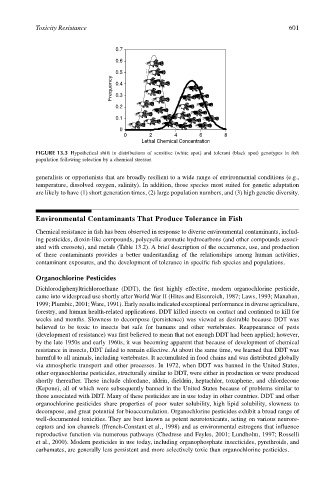Page 621 - The Toxicology of Fishes
P. 621
Toxicity Resistance 601
0.7
0.6
0.5
Frequency 0.4
0.3
0.2
0.1
0
0 2 4 6 8
Lethal Chemical Concentration
FIGURE 13.3 Hypothetical shift in distributions of sensitive (white spot) and tolerant (black spot) genotypes in fish
population following selection by a chemical stressor.
generalists or opportunists that are broadly resilient to a wide range of environmental conditions (e.g.,
temperature, dissolved oxygen, salinity). In addition, those species most suited for genetic adaptation
are likely to have (1) short generation times, (2) large population numbers, and (3) high genetic diversity.
Environmental Contaminants That Produce Tolerance in Fish
Chemical resistance in fish has been observed in response to diverse environmental contaminants, includ-
ing pesticides, dioxin-like compounds, polycyclic aromatic hydrocarbons (and other compounds associ-
ated with creosote), and metals (Table 13.2). A brief description of the occurrence, use, and production
of these contaminants provides a better understanding of the relationships among human activities,
contaminant exposures, and the development of tolerance in specific fish species and populations.
Organochlorine Pesticides
Dichlorodiphenyltrichloroethane (DDT), the first highly effective, modern organochlorine pesticide,
came into widespread use shortly after World War II (Hites and Eisenreich, 1987; Laws, 1993; Manahan,
1999; Plumbic, 2001; Ware, 1991). Early results indicated exceptional performance in diverse agriculture,
forestry, and human health-related applications. DDT killed insects on contact and continued to kill for
weeks and months. Slowness to decompose (persistence) was viewed as desirable because DDT was
believed to be toxic to insects but safe for humans and other vertebrates. Reappearance of pests
(development of resistance) was first believed to mean that not enough DDT had been applied; however,
by the late 1950s and early 1960s, it was becoming apparent that because of development of chemical
resistance in insects, DDT failed to remain effective. At about the same time, we learned that DDT was
harmful to all animals, including vertebrates. It accumulated in food chains and was distributed globally
via atmospheric transport and other processes. In 1972, when DDT was banned in the United States,
other organochlorine pesticides, structurally similar to DDT, were either in production or were produced
shortly thereafter. These include chlordane, aldrin, dieldrin, heptachlor, toxaphene, and chlordecone
(Kepone), all of which were subsequently banned in the United States because of problems similar to
those associated with DDT. Many of these pesticides are in use today in other countries. DDT and other
organochlorine pesticides share properties of poor water solubility, high lipid solubility, slowness to
decompose, and great potential for bioaccumulation. Organochlorine pesticides exhibit a broad range of
well-documented toxicities. They are best known as potent neurotoxicants, acting on various neurore-
ceptors and ion channels (ffrench-Constant et al., 1998) and as environmental estrogens that influence
reproductive function via numerous pathways (Chedrese and Feyles, 2001; Lundholm, 1997; Rosselli
et al., 2000). Modern pesticides in use today, including organophosphate insecticides, pyrethroids, and
carbamates, are generally less persistent and more selectively toxic than organochlorine pesticides.

